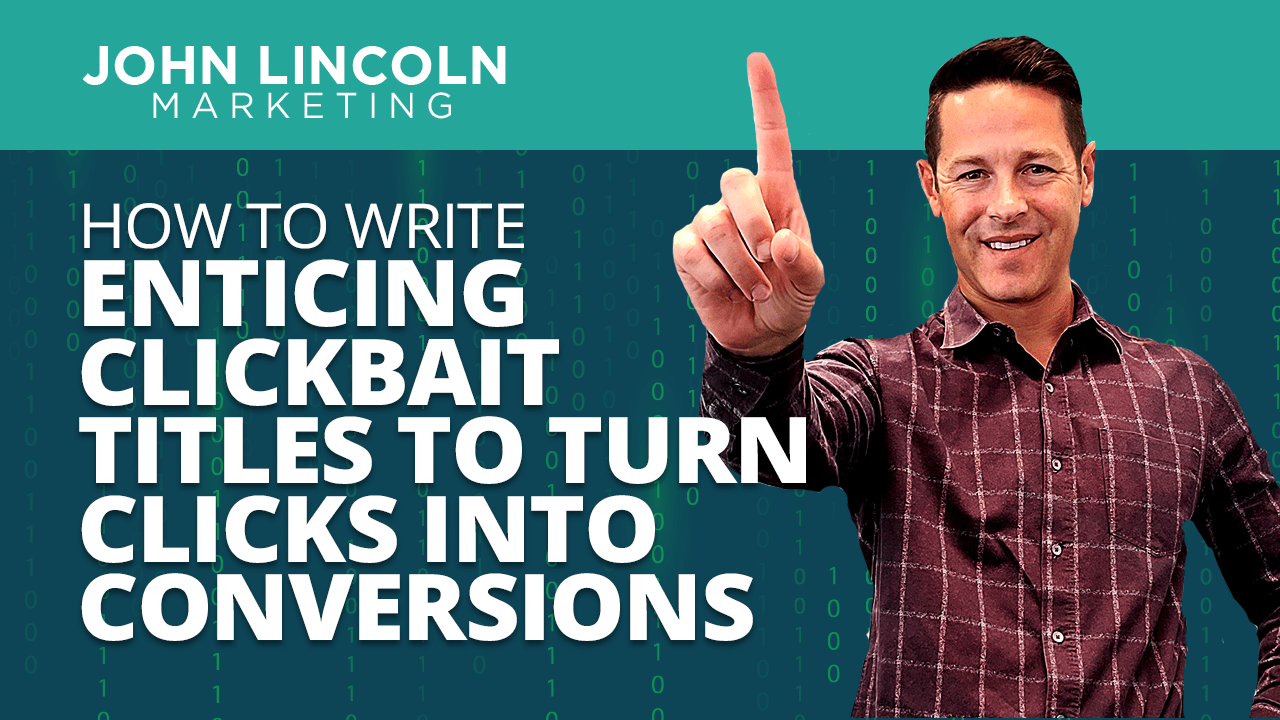How to Write Enticing Clickbait Titles To Turn Clicks Into Conversions

Before you throw in the towel, there may be a way to fix this. And luckily, the answer could be as simple as changing up your headlines.
If you’re ready to convert forgettable headers into attention-grabbing clickbait titles, keep reading!
What We’ll Cover:
- Clickbait Defined
- Importance of Creating Effective Clickbait Titles
- Include Keywords
- Highlight the Benefits
- Deliver on Your Promises
- Create Hype
Clickbait Defined
When people think of clickbait, what usually comes to mind is headlines that are manipulative, dishonest, or just outright ridiculous.
Despite the negative connotations associated with the word, clickbait does what all marketers want—it encourages readers to explore more of their online content.
Clickbait titles tend to appeal to people’s emotions, which is why they so often compel users to take action.
In fact, a recent study found that some of the most common clickbait techniques included a combination of the following:
- Listicles
- Use of “You” or “I”
- An animal
- Trending or breaking news topics
- An element of shock
- A pop culture or food reference
The study also revealed that 46% of the titles used in highly shared content had at least 3 of these elements.
Clickbait works—plain and simple. But can it work for your business? When used appropriately, absolutely.
Negative Impacts
However, when clickbait is used negatively it can affect your website – and not in a good way.
The nature of clickbait titles is to help make a piece of content go viral, attracting users from all over the world, with various interests and backgrounds.
Unfortunately, not every single one of them will be interested in what your site really has to say. Those outside of your target audience will most likely be disappointed, causing them to leave your site, skyrocketing your bounce rate.
In addition to a high bounce rate, clickbait titles are often associated with fake news. And that’s the last thing you want for your site.
Clickbait or Spam?
Treading the line between effective clickbait and spam can be difficult.
Spam comes in many forms but the most popular is fake news, misleading information that is presented as news.
Spam can damage your website’s reputation and deter users.
So how do you make sure your clickbait titles will draw readers in instead of repelling them?
Follow along to learn about the importance of creating effective clickbait titles and discover what features to incorporate.
Importance of Creating Effective Clickbait Titles
For every blog post you write, there are likely dozens, if not hundreds, of other articles online that have been created around a similar topic.
All of these blogs are competing for clicks, shares, search rankings, and the attention of your readers.
With that being said, if your audience finds your headlines dull and uninteresting, they won’t be motivated to read the rest of your blog post. If they find your titles misleading or full of false information, they won’t be motivated to visit your site again.
The only way to ensure that your content stands out from the crowd is to write a headline that provokes curiosity without misrepresenting the information they’ll find on the page—a clickbait title.
According to Peter Koechley, co-founder of Upworthy.com, “The difference between a good headline and a bad headline can be just massive. It’s not a rounding error. When we test headlines we see 20% difference, 50% difference, 500% difference. A really excellent headline can make something go viral.”
Next, we’ll dive into some guiding principles to crafting powerful clickbait titles that will hook readers and drive traffic.
Include Keywords
Keywords are the building blocks of search. That’s why the first step in writing a killer clickbait headline is making a list of keywords related to your topic.
Once you have zeroed in on a keyword you want to use, run a quick Google search with that term and take a look at the search results. And even if it’s difficult to use the exact keyword people are searching for, you have some leeway as Google will still attempt to match the query to the most relevant keyword.
For instance, say a user is looking out for the keyword “San Diego lawyer.” Since it’s tough to include this keyword in a headline that makes grammatical sense, you can opt for the phrase “lawyers in San Diego” as well.
Feel free to check out online tools like Google Trends and Keyword Planner to find SEO-rich keywords for your clickbait titles.
Highlight the Benefits
If you want to use the power of clickbait for good, you need to prove your worth to your readers.
What are you offering? What should they expect to receive from clicking on your link?
Everyone is in a rush these days, so asking users to stop whatever they’re doing to read your content without providing some kind of benefit is a tall order to ask. If you want them to invest their time in your brand, be sure to provide them with something valuable in return.
Here are a few benefit-driven clickbait examples that got it right:
- “This is How Small Business Owners are Saving Thousands on Their Taxes”
- “Find Out How Freelancers Can Make More Money with Fewer Clients”
- “How to Become a Real Estate Mogul with Only $8,000”
Deliver on Your Promises
When a user visits your website, they’re typically looking for a solution to a problem, which means you need to make it clear in your title how reading your blog post will help them.
It doesn’t matter how big or small your promise is—as long as you deliver.
When your clickbait titles overpromise, you end up deceiving readers and betraying their trust. While this may happen unintentionally, it’s important to continually evaluate the success of your articles.
If some of your posts aren’t performing as well as others, review your headlines to see if maybe you could have communicated your message a bit better.
Clickbait examples like “See Your Traffic Double in Just 3 Weeks” or “You Can Now Land More Clients Without Breaking the Bank“are great because they imply that readers can now achieve something they weren’t able to before. But, you need to follow through on these claims if you want to secure your brand’s credibility.
Create Hype
You’ve likely come across several clickbait headlines that make use of terms such as “shocking”, “unbelievable”, and “you won’t believe”.
These kinds of leads have a knack for drawing the user in before they’ve even gotten a chance to process the title.
In this case, you want to strike a balance between intriguing your reader and offering up just enough information to get them to click through to your content.
Something like “7 Surprising SEO Tricks You Didn’t Know” or “12 Shocking Marketing Statistics You Won’t Believe” will provide the right level of mystery and shock value to attract readers.
Wrapping Up
The title of your content is pivotal to how it will be received by your prospects and how it will perform in the search engine results pages.
But the good news is that your clickbait titles don’t have to be spammy, sensationalist, or misleading to produce the desired results.
By applying the tactics we’ve outlined in this guide to your marketing strategy, you can write attention-grabbing titles without risking your brand’s reputation and start turning clicks into conversions in no time!
Welcome To John Lincoln Marketing
Welcome to John Lincoln’s personal website. You can learn about John Lincoln’s books, films, book him to speak and contact him. John is directly associated with many of the businesses mentioned on this website and freely discloses this information.
About the Author

John Lincoln is CEO of Ignite Visibility, one of the top digital marketing agencies in the nation. Ignite Visibility is a 6x Inc. 5,000 company. Ignite Visibility offers a unique digital marketing program tied directly to ROI with a focus on using SEO, social media, paid media, CRO, email and PR to achieve results. Outside of Ignite Visibility, Lincoln is a frequent speaker and author of the books Advolution, Digital Influencer and The Forecaster Method. Lincoln is consistently named one of the top digital marketers in the industry and was the recipient of the coveted Search Engine Land “Search Marketer of The Year” award. Lincoln has taught digital marketing and Web Analytics at the University of California San Diego since 2010, has been named as one of San Diego’s most admired CEO’s and a top business leader under 40. Lincoln has also made “SEO: The Movie” and “Social Media Marketing: The Movie.” His business mission is to help others through digital marketing.
Get Social
Contact John Lincoln
Want to get in touch with John Lincoln? Click Here To Reach Out.
Related Posts

Top 16 Questions to Ask a PPC Company in 2024
In 2024, choosing the right PPC company is not just about spending your advertising budget. You want to make every cent count towards your business

The Ultimate Guide to Conversion Rate Optimization for Any Business
Whether you’re a seasoned marketer or just starting out, conversion rate optimization (CRO) is a powerful tool that can boost your sales, leads, and overall

16 Questions to Help You Choose an SEO Company
Feeling overwhelmed by the sea of SEO companies out there? You’re not alone! Choosing the right partner is crucial for achieving your online marketing
